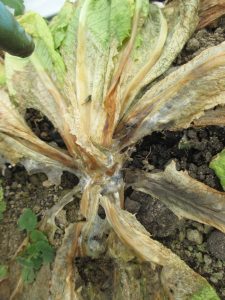Cool season crops such as lettuce are becoming a more popular crop among Indiana greenhouse/high tunnel growers. One of the most important diseases of lettuce is known as lettuce drop.
The symptoms of lettuce drop are often noticed after the thinning stage, early in the crop development. The early symptoms may include browning of leaves. Later on in the crop development, the outer most leaves of the lettuce plant may wilt. As the disease become more severe, inner leaves may become infected. Eventually, the entire plant may collapse. The plant often has white mold on the leaves and dark irregular fruiting bodies may be observed (Figure 1). The dark fruiting bodies are known as sclerotia.

Figure 1: The symptoms of lettuce drop include a white mold that covers much of the plant and the dark, irregular sclerotia that are observed here. (Photo by Wenjing Guan).
Two different organisms may be responsible for lettuce drop. Sclerotina sclerotiorum and S. minor.
Lettuce drop caused by S. sclerotiorum requires a chilling period (52 to 59° F) for the sclerotia to turn into mushrooms smaller than a dime. These mushrooms then produce spores that may cause disease of lettuce if there is adequate leaf wetness. S. minor, in contrast, is seldom caused by spores from a mushroom. Instead, lettuce drop caused by S. minor is often caused by direct germination of the sclerotia in the soil.
In summary, S. sclerotiorum usually causes disease through mushrooms that sprout after a sufficient chilling period. Thus, mushrooms some distance away from the lettuce could cause S. sclerotiorum infection. S. minor mostly causes disease through direct germination of sclerotia in the soil. S. minor infections, therefore, are most likely the result of close contact with soil infested with sclerotia.
It is my opinion that lettuce drop in Indiana greenhouses is more likely caused by S. sclerotiorum. Part of the reason for this belief is that S. sclerotiorum is the same organism responsible for white mold of tomato. Tomato is a common crop in Indiana greenhouses and is commonly rotated with lettuce. Also, sclerotia produced by S. sclerotiorum tend to be larger and more irregularly shaped than those produced by S. minor. The sclerotia in figure 1 are from Indiana and are most likely S. sclerotiorum.
Fungicides may help to reduce the incidence of lettuce drop. Products labeled and either approved or silent on greenhouse use include: Botran 75W®, Cannonball®, Fontelis®, Rovral® and Switch®. The product Contans®, which is organically approved in many systems, is a hyperparasite of both S. sclerotiorum and S. minor. Contans® must be worked into the soil.
Other cultural methods of disease reduction include:
- Deep plow soil to get sclerotia well under the soil surface.
- Long crop rotations with a non-host may help to reduce disease.
- Anything which can be done to increase ventilation/decrease leaf wetness will help to reduce disease severity of lettuce drop caused by S. sclerotiorum.
Please see the Midwest Vegetable Production Guide for Commercial Growers 2016 (ID-56) for more information <mwveguide.org>.